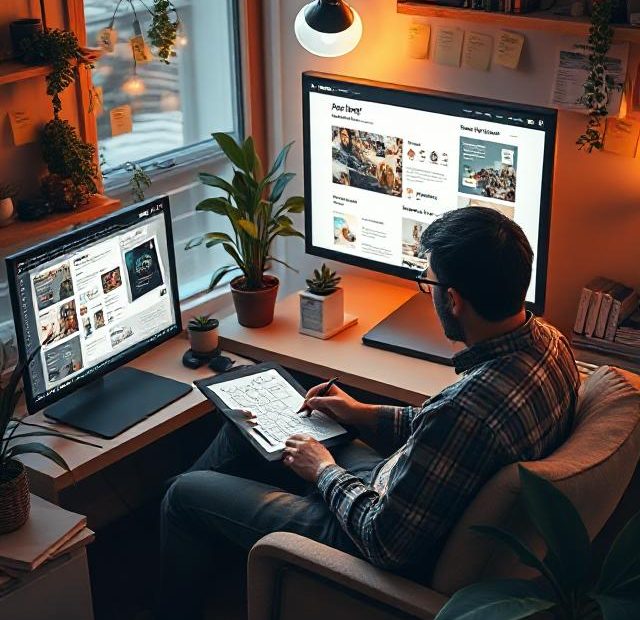You know what? I never thought lines of code could actually say something meaningful to someone. I used to think it’s just CSS and JavaScript slapping pixels around. But nope—it’s more than that.
Sometimes when I’m building a site, I pause and ask: what’s the story here? It sounds weird maybe, but yeah—websites can tell stories. They should, even. People feel something when they land on a page that’s not just blocks and buttons, but a journey.
Every single visitor is looking for something. Not always the same thing, obviously, but a resolution of some kind. A feeling that they’re in the right place, doing the right thing, with the right brand or person or idea.
I don’t build websites just to be looked at. I build them to be experienced, y’know?
Where It Starts? Always With the Person.
So here’s a thing: your user’s the main character. Not you. Not me. Them.
They come in with a problem, some question, maybe just curiosity. Whatever it is—they’re looking for something. The site I’m building has to become part of that solution, like a chapter in their story.
What I do is figure out who they are. Like… not just demographics or age or whatever. Deeper stuff. What’s stressing them? Why they landed here?
Once I understand that, the whole project kinda comes into focus.
Conflict Drives It, Not Design
Web pages without a clear problem to solve? They’re just decoration, honestly.
You need friction. You need tension. Something the user wants to escape, change, fix, learn, whatever. That’s what makes the “story” matter.
Now don’t get me wrong—this ain’t about drama for the sake of it. But if your homepage doesn’t speak to a pain, a fear, a need… then why should someone stay on it?
Resolution Must Be Obvious (and Easy)
If I’ve learned anything from building, it’s this: people won’t work hard to get the ending.
Make it smooth. No dead ends, no mysteries unless you want them confused. I keep things direct—when they scroll down, they should feel like they’re getting closer to their answer.
Ever notice how some sites make you feel good before you even find what you’re looking for? That’s storytelling. That’s pacing.
Visuals Aren’t Decoration, They’re Dialogue
There’s days where I barely write copy. I just design layout, flow, and space. But it still says something, if it’s done right.
A full-width hero with soft shadows? Feels calm. Harsh, contrasty grids? Urgency.
Sometimes the way a button moves when hovered says more than five paragraphs.
Oh, and colors—they’re silent narrators. Blue talks trust. Orange? Energy. Black is a power move. You feel it before you think it.
Write Like You Mean It (Or Just Don’t)
A lotta sites sound like a committee wrote them while half-asleep. Buzzwords. Boring as cement.
Nah. I speak like a real person. Direct, sometimes a little offbeat. Like I’m actually trying to help, not sell.
You know what line I once used on a client site?
“Let’s make your Mondays suck less.”
That converted like crazy. Don’t overthink tone. Be honest. Be helpful. Be human.
Build Flow Like a Script, Not a Sitemap
Nobody likes a confusing movie. Same with sites.
The top should hook, the middle should explain, and the bottom? That’s your resolution. Call to action, payoff, whatever.
I use scroll depth and transition animations to guide that arc. It’s not fancy—just rhythm. Like editing a film.
People should scroll and feel like they’re going somewhere, not just wandering pixels.
Other Characters = Social Proof
So yeah, testimonials and user stories? Super useful. Not just for marketing, but for narrative.
It’s like when you’re watching a movie and a side character says, “I tried it and it worked.” Suddenly, you trust the hero more.
Put real names, faces, tiny details. No one trusts a review from “Happy Client #392.”
Your Code Carries Emotion (Really)
Don’t laugh, but sometimes I feel like even the HTML itself has a tone.
If it’s clean and organized, the page loads fast and acts smooth—it just feels friendly. Like a site that wants you to win.
If it’s slow and glitchy? That’s tension you didn’t mean to create. That’s the story breaking down.
Errors and Forms? Still Part of the Plot
Imagine you’re reading a novel and the next page won’t load. That’s what a broken form feels like.
I try to give even my error messages personality. Instead of “Invalid input,” I’ll write “Hmm, that doesn’t look right. Wanna try again?”
Makes a difference. People forgive a site that talks to ‘em like a person.
Don’t Be the Hero—Be the Guide
Real talk? Most sites try to be the star of the show. Bad idea.
You’re not Luke Skywalker. You’re Yoda.
The user is on a quest. You’re here to help. To equip, encourage, clear the path. That’s it.
If your site feels like a spotlight, dim it. Light the way instead.
In Closing? Build Feelings, Not Just Functions
At the end of it all, I just wanna make people feel something when they use what I built.
Could be clarity. Comfort. Curiosity. Hope. Excitement. Doesn’t matter what, really—just don’t make ‘em feel nothing.
Because code alone doesn’t move people. But stories? They do.
Also, you can learn more about in Simplify Your UI startups here.
